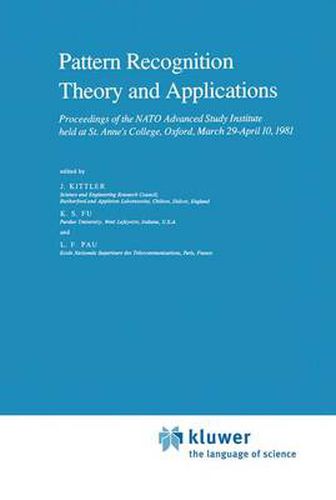Readings Newsletter
Become a Readings Member to make your shopping experience even easier.
Sign in or sign up for free!
You’re not far away from qualifying for FREE standard shipping within Australia
You’ve qualified for FREE standard shipping within Australia
The cart is loading…






This title is printed to order. This book may have been self-published. If so, we cannot guarantee the quality of the content. In the main most books will have gone through the editing process however some may not. We therefore suggest that you be aware of this before ordering this book. If in doubt check either the author or publisher’s details as we are unable to accept any returns unless they are faulty. Please contact us if you have any questions.
This book is the outcome of the successful NATO Advanced Study Institute on Pattern Recognition Theory and Applications, held at St. Anne’s College, Oxford, in April 1981., The aim of the meeting was to review the recent advances in the theory of pattern recognition and to assess its current and future practical potential. The theme of the Institute - the decision making aspects of pattern recognition with the emphasis on the novel hybrid approaches - and its scope - a high level tutorial coverage of pattern recognition methodologies counterpointed with contrib uted papers on advanced theoretical topics and applications - are faithfully reflected by the volume. The material is divided into five sections: 1. Methodology 2. Image Understanding and Interpretation 3. Medical Applications 4. Speech Processing and Other Applications 5. Panel Discussions. The first section covers a broad spectrum of pattern recognition methodologies, including geometric, statistical, fuzzy set, syntactic, graph-theoretic and hybrid approaches. Its cove,r age of hybrid methods places the volume in a unique position among existing books on pattern recognition. The second section provides an extensive treatment of the topical problem of image understanding from both the artificial intelligence and pattern recognition points of view. The two application sections demonstrate the usefulness of the novel methodologies in traditional pattern ‘recognition application areas. They address the problems of hardware/software implementation and of algorithm robustness, flexibility and general reliability. The final section reports on a panel discussion held during the Institute.
$9.00 standard shipping within Australia
FREE standard shipping within Australia for orders over $100.00
Express & International shipping calculated at checkout
This title is printed to order. This book may have been self-published. If so, we cannot guarantee the quality of the content. In the main most books will have gone through the editing process however some may not. We therefore suggest that you be aware of this before ordering this book. If in doubt check either the author or publisher’s details as we are unable to accept any returns unless they are faulty. Please contact us if you have any questions.
This book is the outcome of the successful NATO Advanced Study Institute on Pattern Recognition Theory and Applications, held at St. Anne’s College, Oxford, in April 1981., The aim of the meeting was to review the recent advances in the theory of pattern recognition and to assess its current and future practical potential. The theme of the Institute - the decision making aspects of pattern recognition with the emphasis on the novel hybrid approaches - and its scope - a high level tutorial coverage of pattern recognition methodologies counterpointed with contrib uted papers on advanced theoretical topics and applications - are faithfully reflected by the volume. The material is divided into five sections: 1. Methodology 2. Image Understanding and Interpretation 3. Medical Applications 4. Speech Processing and Other Applications 5. Panel Discussions. The first section covers a broad spectrum of pattern recognition methodologies, including geometric, statistical, fuzzy set, syntactic, graph-theoretic and hybrid approaches. Its cove,r age of hybrid methods places the volume in a unique position among existing books on pattern recognition. The second section provides an extensive treatment of the topical problem of image understanding from both the artificial intelligence and pattern recognition points of view. The two application sections demonstrate the usefulness of the novel methodologies in traditional pattern ‘recognition application areas. They address the problems of hardware/software implementation and of algorithm robustness, flexibility and general reliability. The final section reports on a panel discussion held during the Institute.